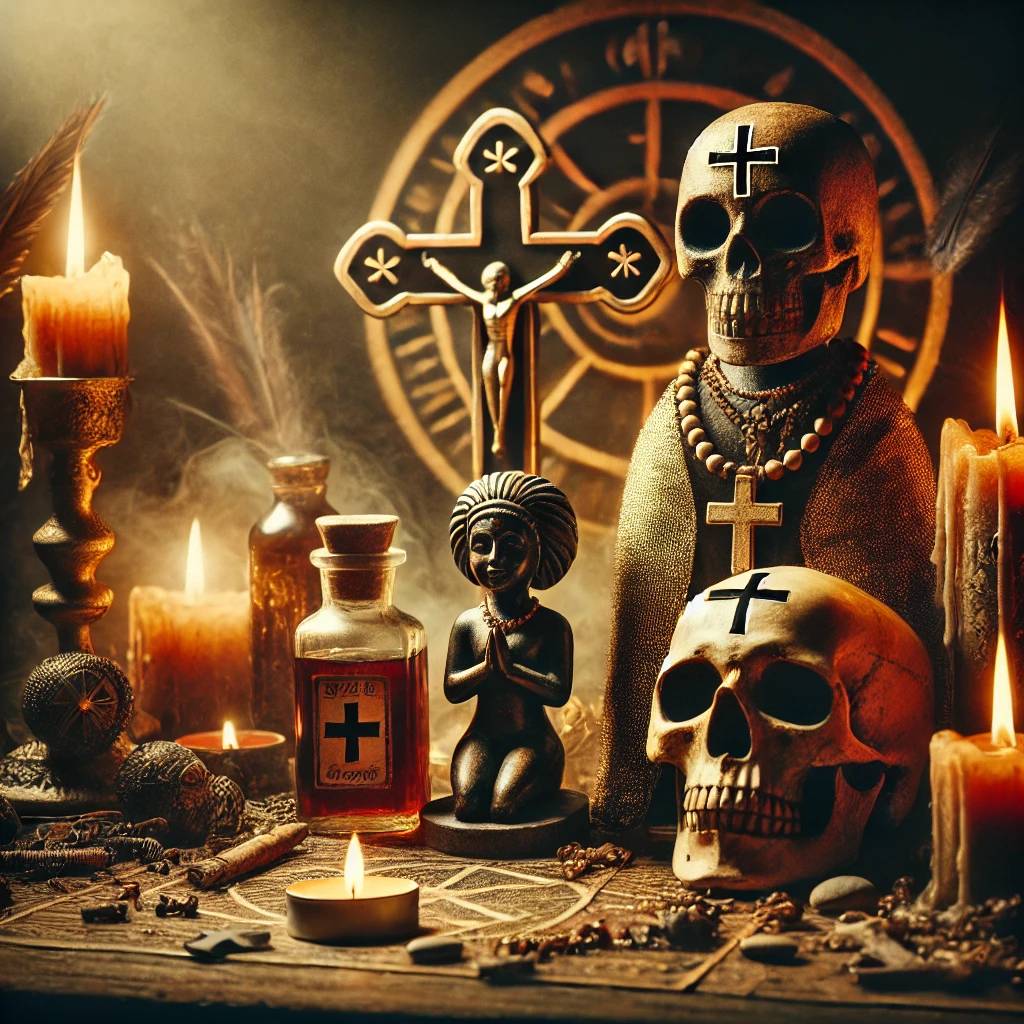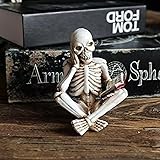In Voodoo, the Gede spirits are a family of powerful lwa (spirits) who rule over life, death, and the mysteries of the afterlife. Known for their dual nature—playful yet profound, protective yet irreverent—the Gede spirits embody the balance between the joys of life and the inevitable reality of death. As guardians of the afterlife and protectors of the dead, the Gede family offers guidance, healing, and even humor to those who seek their presence.
This article delves into the role of the Gede spirits, their symbols, offerings, and how they’re honored in Voodoo practice. By understanding the Gede, we gain insight into Voodoo’s unique perspective on mortality and the cycles of life.
Behold a Pale Horse
$17.97 (as of December 25, 2025 18:12 GMT +00:00 - More infoProduct prices and availability are accurate as of the date/time indicated and are subject to change. Any price and availability information displayed on [relevant Amazon Site(s), as applicable] at the time of purchase will apply to the purchase of this product.)Who Are the Gede Spirits?
The Gede spirits are both feared and beloved in Voodoo, embodying death, rebirth, and the continuity of life. They are often seen as the gatekeepers of the afterlife, helping spirits transition from the physical realm to the spiritual. Despite their connection to death, the Gede are full of life, often portrayed with humor, wisdom, and an irreverent attitude that challenges traditional notions of death as something to fear.
1. The Family of Gede Spirits: Baron Samedi, Maman Brigitte, and the Gedes
The Gede family includes various powerful spirits, each with unique attributes. The most prominent among them are Baron Samedi and Maman Brigitte, who serve as leaders of the Gede. Baron Samedi is the lwa of death and resurrection, while Maman Brigitte is his fierce partner, known for her justice and healing powers. Together, they oversee the Gede spirits, ensuring balance between life and death.
- Baron Samedi: Often depicted with a top hat, dark glasses, and a cigarette or cigar, Baron Samedi is the charismatic lwa of the dead. He is the master of the cemetery and oversees the transition from life to death, embodying both solemnity and humor.
- Maman Brigitte: Known for her protective and nurturing nature, Maman Brigitte watches over the dead and is often called upon for justice and healing. She is represented by purple and black colors and is a beloved figure among those who seek her guidance and protection.
Fact:
The Gede spirits are celebrated each November during Fèt Gede, a festival honoring the dead, where practitioners perform rituals, make offerings, and celebrate life with the Gede’s characteristic humor and energy.
2. A Spirit of Life and Death
While the Gede spirits are guardians of death, they are also symbols of life, reminding practitioners that mortality should not overshadow the joys of living. Their humorous antics and irreverent nature bring a refreshing perspective to life’s inevitable end, teaching that death is part of the natural cycle.
- Embodying Life’s Duality: The Gede spirits represent both life and death, teaching that each complements the other. Their presence encourages practitioners to embrace life fully while accepting death as a natural transition.
- Bringers of Healing and Renewal: The Gede spirits are also known for their healing powers, providing comfort to those dealing with loss, trauma, or illness. They use their understanding of death to help the living find peace and healing.
Example:
A grieving person may call upon the Gede spirits to find comfort and healing, seeking their wisdom to process loss and their humor to remember life’s lighter side.
1 Piece Halloween Skeleton Decoration Gothic Cross-Legged and Reading Skull Figurine Exquisite Horror Sculpture for Desk Bookshelf Fireplace Party Living Room Office Decor
$9.54 (as of December 25, 2025 18:12 GMT +00:00 - More infoProduct prices and availability are accurate as of the date/time indicated and are subject to change. Any price and availability information displayed on [relevant Amazon Site(s), as applicable] at the time of purchase will apply to the purchase of this product.)Symbols and Colors Associated with the Gede Spirits
In Voodoo, each lwa has symbols, colors, and attributes that reflect their unique essence. For the Gede spirits, these symbols emphasize their connection to life, death, and the wisdom they bring.
1. Colors of the Gede Spirits
The Gede spirits are associated with black, purple, and white, representing death, transformation, and purity. These colors are often used in candles, cloth, and altar arrangements to honor the Gede during rituals.
- Black: Symbolizes death, mystery, and protection, emphasizing the Gede’s role as guardians of the afterlife.
- Purple: Represents spiritual power, wisdom, and transformation, often associated with Maman Brigitte and the mysteries of the spirit world.
- White: Symbolizes purity and peace, often used to honor the souls of the dead and bring a sense of calm and reverence to the rituals.
Example:
During Fèt Gede, practitioners may light candles in black, purple, and white to honor the Gede spirits, creating an atmosphere that reflects their dual nature.
2. Symbols and Sacred Objects
The Gede spirits are represented by symbols that highlight their connection to death, life, and the afterlife. These symbols are commonly used in rituals to honor them and invite their presence.
- Skulls and Crossbones: Representing death and the afterlife, skulls and crossbones are frequently associated with the Gede, symbolizing their role as guardians of the dead.
- Cigars, Rum, and Sunglasses: These items are specific to Baron Samedi, symbolizing his laid-back yet powerful presence. Cigars and rum are often placed on his altar as offerings.
- Veve of the Gede: The veve, or sacred drawing, for the Gede family includes symbols of skulls, bones, and crosses, reflecting their connection to the afterlife. Practitioners draw the veve during rituals to invite the Gede spirits and honor their role.
Example of an Altar Setup:
An altar dedicated to the Gede spirits may include black and purple candles, skull symbols, a cigar, and a small bottle of rum, creating a space that reflects their protective and playful nature.
Offerings to the Gede Spirits
In Voodoo, offerings are a way to show respect and gratitude to the lwa. The Gede spirits appreciate offerings that reflect their bold, humorous nature. These offerings often include rum, cigars, and spicy foods.
1. Common Offerings for the Gede Spirits
Offerings to the Gede spirits are often vibrant, reflecting their lively and mischievous personalities. Practitioners make these offerings to honor their role in life and death, seeking protection, guidance, or healing.
- Rum and Cigars: Rum and cigars are favored by the Gede spirits, especially Baron Samedi. These items symbolize warmth, hospitality, and respect for their wisdom.
- Spicy Foods and Hot Peppers: Known for their bold nature, the Gede appreciate spicy foods, which reflect their intensity and passion.
- Black and Purple Candles: Black and purple candles are commonly used to honor the Gede, creating a mysterious and transformative atmosphere.
2. Setting Up an Altar with Offerings
Setting up an altar for the Gede requires respect and a touch of humor, creating a space that honors their playful energy while acknowledging their protective role. Practitioners arrange offerings carefully to invite the Gede’s guidance and protection.
- Candles and Colors: Black, purple, and white candles are typically lit on the Gede altar, creating an atmosphere that reflects the dual nature of life and death.
Example:
A practitioner may set up an altar for the Gede with a glass of rum, a cigar, black candles, and a skull symbol, creating an environment that honors their lively yet protective presence.
Invoking the Gede Spirits in Voodoo Rituals
The Gede are typically invoked in rituals for protection, healing, and remembrance. Their presence brings humor, wisdom, and resilience, helping practitioners face life’s challenges and find comfort in times of loss.
1. Prayers and Invocations to the Gede
Prayers to the Gede spirits are often lighthearted yet respectful, reflecting the spirits’ humorous and bold nature. Practitioners may recite formal prayers or speak from the heart, asking for the Gede’s protection, healing, or insight.
- Prayer Example: “Gede spirits, guardians of life and death, I call upon you. Grant me your wisdom, your laughter, and your strength. Help me face life’s challenges with courage, and stand with me in times of transition.”
2. Rituals for Protection and Healing
The Gede are often invoked in rituals for protection and healing, especially in situations involving illness or loss. Their presence provides comfort, guidance, and a reminder of the resilience needed to navigate life’s hardships.
- Healing Ritual: To seek healing, a practitioner might light a black or purple candle, place a small offering of rum or spicy food on the altar, and ask the Gede for comfort and strength.
- Protection and Guidance Ritual: For protection, practitioners may set up an altar with a skull symbol, a cigar, and candles, asking the Gede to watch over them and provide strength in times of difficulty.
Fact:
The Gede spirits’ energy is particularly beneficial for those grieving or facing major life transitions, as they embody the wisdom and resilience needed to accept life’s inevitable cycles.
The Significance of the Gede Spirits in Voodoo Spirituality
The Gede spirits play a central role in Voodoo as the guardians of life and death, representing the balance between joy and sorrow, life and afterlife. Their presence reminds practitioners of the importance of embracing life with humor and resilience, even as they honor death. Through the Gede, Voodoo spirituality emphasizes the natural cycle of life, teaching that death is a transition rather than an end.
By honoring the Gede, practitioners find strength, resilience, and the courage to face life’s transitions. Their energy provides comfort in times of grief, guidance during hardship, and a reminder that life is a precious, joyful journey, even in the face of mortality.
Thanosis
$19.95 (as of December 25, 2025 18:12 GMT +00:00 - More infoProduct prices and availability are accurate as of the date/time indicated and are subject to change. Any price and availability information displayed on [relevant Amazon Site(s), as applicable] at the time of purchase will apply to the purchase of this product.)Honoring the Gede in Voodoo Practice
The Gede spirits, as guardians of life and death, bring a unique energy to Voodoo that is both protective and playful. By honoring them with offerings, rituals, and respect, practitioners invite their wisdom, resilience, and humor into their lives, seeking guidance through life’s challenges and comfort in times of transition. The Gede remind us that life and death are inseparable, and both should be faced with reverence and courage.
Related Articles
- Who are the Gede Spirits? Understanding the Guardians of Life and Death
- Simbi: The Spirit of Water, Knowledge, and Magic
- Legba vs. Met Kalfou: Understanding the Spirits of the Crossroads
- Lasirèn: The Mystical Spirit of the Sea and Healing
- Azaka: The Spirit of Agriculture and Hard Work
More from This Category
- The Role of Baron Samedi in Voodoo: Spirit of Death and the Afterlife
- Erzulie Dantor: The Fierce Protector of Women and Children
- Damballah: The Serpent Spirit of Wisdom and Renewal
- Ogou: The Warrior Spirit of Strength and Protection in Voodoo
- Erzulie Freda: The Spirit of Love, Beauty, and Passion in Voodoo
- Who is Papa Legba? Understanding the Gatekeeper of the Spirit World



